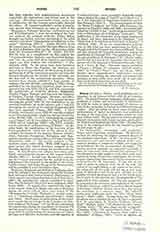

Nunez (Noxius), Pedro, mathematician and astronomer, b. at Alcacer-do-Sol, 1492; d. at Coimbra, 1577. He studied ancient languages, philosophy, and medicine at Lisbon and mathematics at Salamanca. In 1519 he went as inspector-general of customs to Goa, India, returning to become in 1529 royal cosmographer. After lecturing for three years at Lisbon, a professorship of higher mathematics was established for him at the University of Coimbra, which he held from 1544 to 1562. His utterances on science plunged him into discussions with foreign savants, particularly the French mathematician, Oronce Fine. Having been tutor in the reigning family, he was enabled to spend his last years in ease.
To mathematics, astronomy, and navigation, Nunez made important contributions. He devised a method for obtaining the highest common divisor of two algebraic expressions. In his “De crepusculis” he announced a new and accurate solution of the astronomical problem of minimum twilight and suggested an instrument for the measurement of angles. The nonius, never in common use, consisted essentially of forty-six concentric circles divided into quadrants by two diameters at right angles to each other, each quadrantal arc being divided into equal parts, the number of parts diminishing from ninety for the outermost arc to forty-five for the innermost. If one side of any angle is made to coincide with one of the radii, the vertex of the angle falling at the center of the circles, the other side of the angle will fall on or near some point of division of one of the arcs. If then a is the number of parts intercepted and n is the whole number of parts in the relevant arc, the magnitude of the angle will be 90 x a/n degrees. In “De arte navigandi” he announced his discovery and analysis of the curve of double curvature called the rumbus, better known as loxodrome, which is the line traced by a ship cutting the meridians at a constant angle. His collected works were published under the title “Petri Nonii Opera” (Basle, 1592). Among them are: “Tratado da sphera com a theorica do sol e da lua e o primeiro livro da geographia de Claudio Ptolomeo Alexandrino” (Lisbon, 1537); “De crepusculis liber unus” (Lisbon, 1542); “De arte atque ratione navigandi” (Coimbra, 1546); “De erratis Orontii Finei” (Coimbra, 1546); “Annotatio in extrema verba capitis de climatibis” (Cologne, 1566); “Livro de algebra emarithrnetica e geometria” (Antwerp, 1567); “Annotagoes a Mechanica de Aristoteles e as theoricas dos planetas de Purbachio com a arte de Navegar” (Coimbra, 1578).
PAUL H. LINEHAN

